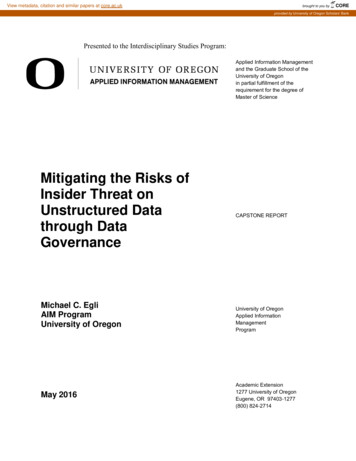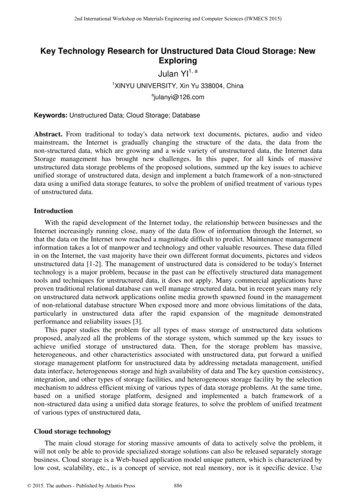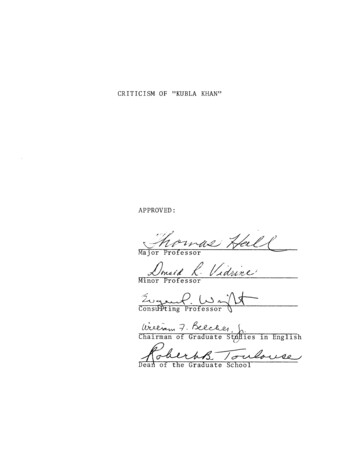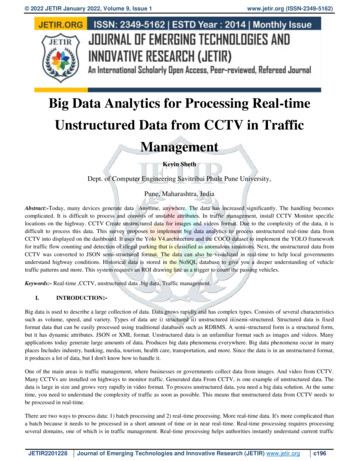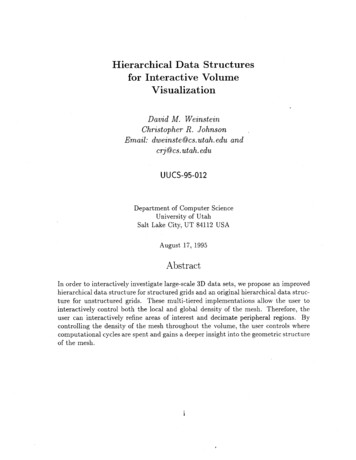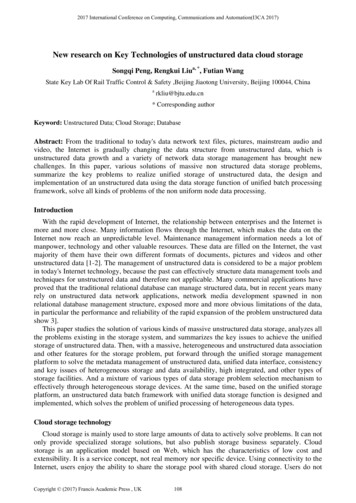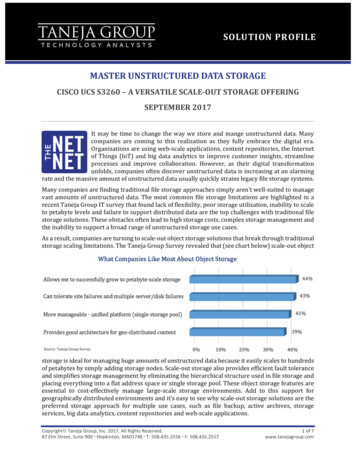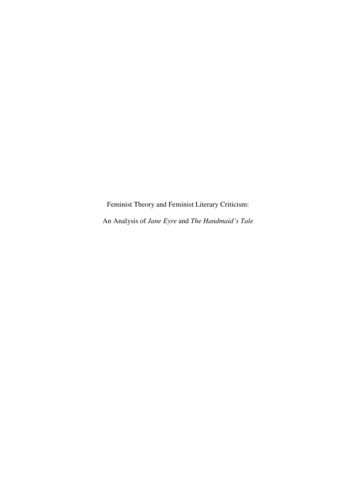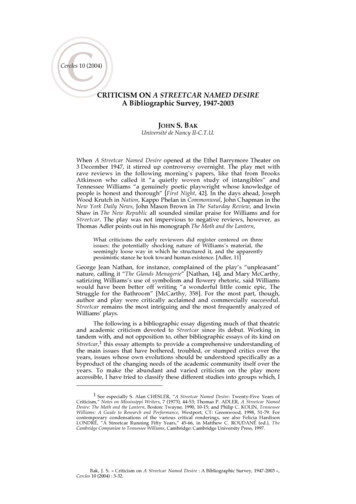
Transcription
Whitepaper .Table of ContentsIntroduction . 2Why MonitorUnstructured Data?Use Cases. 3. 4Avoiding PerformanceIssues . 6Architecture . 6Features . 9File ActivityMonitoring . 10Content and Context . 11Using Big Data Analyticsto Mitigate Risk . 12Monitoring UnstructuredDataUniting Multi-Protocol Storage and Cross-PlatformAccess Control for File Activity Monitoring andContext-Aware SecurityExecutive SummaryUnstructured data is rapidly piling up in file servers and NAS systems – and 40percent of it tends to be sensitive information: intellectual property, confidential data,and company secrets.Monitoring the data, however, is harder than storing it. Because the unstructureddata of Unix users is typically stored in separate silos from the data of Windowsusers, it is problematic to track the data with a single, standardized monitoringsystem.The problem of monitoring across silos is compounded by incompatible identitymanagement systems for Unix and Windows users, making it hard for standardizedmonitoring to link users with their identities. Compliance regulations, disclosurelaws, and risk management, though, require security that identifies threats based onuser identities.Big Data andBusiness Intelligence . 12This white paper argues that a multi-protocol file server or NAS system with anintegrated cross-platform access control system is a blueprint to efficiently andeffectively monitor unstructured data.Conclusion . 12First, it frees you from the silos of platform-specific storage, empowering you tomonitor all the stored data without regard for storage protocol.Ten Steps toEffective Monitoring . 14Second, it secures the unstructured data by applying a common security modelto it, enabling the monitoring system to associate access with user identities andorganizational roles.By Steve Hoenisch,Likewise SoftwareWWW.LIKEWISE.COMThird, it establishes the foundation for a high-performance file activity monitoringsystem that can track unstructured content in a security-aware context of userWHITEPAPER 1
identities, patterns of access, and file change events.The result is an identity-aware, cross-platform storage system that makes it easy tosecure unstructured data from internal threats, monitor user access, track changesto sensitive files, and generate reports that demonstrate regulatory compliance withevidence.IntroductionUnstructured data is growing faster than all other types of data, industry analystssay. It will increase by as much as 800 percent during the next five years – andmore than 40 percent of it, a survey by the Aberdeen Group found, is sensitive. Ifthe data is sensitive, it must be protected: Compliance regulations, disclosure laws,and risk mitigation mandate security.Meanwhile, industry analysts report that IT security managers are evaluatingdatabase activity monitoring tools to comply with regulations and to manage risksassociated with structured data stored in databases. Database activity monitoring,however, focuses on structured data without placing a corresponding emphasis onrapidly growing file repositories, exposing a large security hole. For comprehensivesecurity, activity monitoring tools should thus be implemented to perform thesame security functions -- only in relation to unstructured data. But the monitoringsystem, to be effective, must identify threats based on user identities across datasilos.Data silos proliferate because there are two main protocols – NFS and CIFS – foraccessing file servers and NAS systems. Unix users access data on file serversby using NFS, while Windows users access data on servers by using CIFS. Theinability to interoperate between the two protocols creates data silos, which aredifficult to monitor with a common system. Ad hoc systems that add a monitoringlayer for file events frequently lead to performance issues.More importantly, though, most monitoring frameworks fail to tie file events touser identities on both Unix and Windows computers. Just as there are differentaccess protocols, there are different, incompatible access control systems for Unixand Windows users that impede the association of identities with events. Whenmonitoring is integrated with a cross-platform identity management system, it hasthe power to link events with user identities.Furthermore, the integration of the identity management system with the activitymonitoring system is a prerequisite for effective exception monitoring – analyzingsuspect events at the nexus of user identity, access, and activity.WWW.LIKEWISE.COMWHITEPAPER 2
In the past, performance issues and poor resulting data have made implementinga useful identity-aware file activity monitoring system impractical. To ensure thatevents do not consume too much network traffic or bog down systems, themonitoring should ultimately take place as part of the file server. For fast writespeeds and horizontal scalability, events should be pushed to a NoSQL database.In a high-volume enterprise, the result of tight integration coupled with a NoSQLdatabase is a system that scales well to deliver high performance.This white paper argues that a multi-protocol file server with an integrated crossplatform access control system establishes a powerful identity-aware framework toefficiently and effectively monitor unstructured data.Why Monitor Unstructured Data?The main business reasons to monitor unstructured data are as follows:WWW.LIKEWISE.COM Protect stored secrets, confidential information, intellectualproperty, and private data. The goal is to control the secrets so theydon’t get into the wrong hands, which could hurt your businessprospects or undermine your competitive advantage. Private data andconfidential information must be protected to meet compliance regulationsand disclosure laws. Demonstrate compliance with regulations, legal requirements,and internal security policies. Some of the key regulations in the UnitedStates are the Health Insurance Portability and Accountability Act(HIPAA), the Payment Card Industry Data Security Standard (PCI DSS),Sarbanes Oxley (SOX), the International Traffic in Arms Regulations (ITAR),and the Federal Information Security Management Act of 2002 (FISMA). Mitigate risk of security breeches, data loss, fraud, noncompliance,and legal problems. Monitoring can detect potential sources of data loss,fraud, incorrect entitlements, inappropriate access attempts, and anomaliesthat are indicators of risk – especially when the monitoring system canassociate data access with user identities. Ensure the quality, integrity, and availability of importantunstructured data. Implementing strong controls over who can access,modify, or delete important unstructured data helps ensure its quality andintegrity. Meantime, when important data is highly available, it can save timeand spur innovation. In a HIPAA environment, highly available data with theright access controls can save lives. Reduce costs associated with records management, storage, andWHITEPAPER 3
security. Although some unstructured data might need to be storedsecurely for years for such reasons as complying with governmentregulations and obtaining patents, storing everything can increase storagecosts. The real value of monitoring, however, lies in its potential to radicallycut the costs associated with security problems.Use CasesThe business justifications above manifest themselves in the following use cases,which demonstrate the need to monitor unstructured data.WWW.LIKEWISE.COM Determine who can access sensitive data and link useridentifiers to people and their organizational roles. Here’s an exampleuse case: As a compliance manager, you want to generate a report thatlists the identities and entitlements of those who can access sensitive data,and you want to be able to map their identities to their organizational rolesso you can vet it for inappropriate access rights. Show what directories and files were changed when and by whom,especially in the face of identities that are inconsistent acrossaccess control systems. Here’s an example: As an auditor, you cannotreconcile the identities of some Windows users with the identities of someUnix users, even though you believe they might be the same peopleaccessing the same content from different machines. Track changes, such as modifications of files or securitydescriptors, as well as attempts to delete content. Example: Asthe security manager, you want to monitor sensitive engineering plans thatare protected from access by those without permission to view them. Inaddition, you want to track denied attempts to access or change files soyou can respond proactively. Monitor controls that protect the integrity of critical unstructureddata. Example: To support HIPAA compliance at a hospital, you mustmonitor the controls that protect the accuracy and completeness of patientdata. You need to monitor who can and does make changes to patientrecords and what changes they make. Tag files with metadata to flag important content for exceptionbased management. Metadata – including metadata for compliance,data governance, or records management – can mark data as sensitive oras falling under a compliance regulation, such as HIPAA. Example: As an ITsecurity manager at a hospital, you want to filter documents covered byWHITEPAPER 4
HIPAA from those that are not, even though both get stored in a NASsystem. Generate a security alert when sensitive files or folders areaccessed, modified, or deleted. Example: As the records managercharged with storing and protecting sensitive files, you want an email alertwhen certain files are accessed or changed. Inspect application data on file servers. Example: As an IT auditor, youfind out that your IT department is increasingly migrating applicationworkloads to filers because it is easier to provision file-based storage thanblock-based storage. As a result, you have a heightened need forexception-based monitoring of application data. Provide context-aware security where the context is theintersection of content, event, access, and identity. Example: As an ITsecurity officer in charge of compliance at a defense company, you seek todesign a file server for sharing classified ITAR-controlled documents. Youmust be able to control who can access and view which content, seewho changes what, monitor for exceptions, and produce reports todemonstrate compliance with ITAR. You must be able to prove thatemployees who are foreign nationals cannot view the documents. Use an analytics engine to discover hidden patterns that couldreveal internal threats or find new value in the data. Example: Asa researcher, you want to analyze all the data from the monitoring systemto extrapolate patterns that can help predict future threats.In addition, the following requirements ensure that the infrastructure has theflexibility to monitor events and generate reports in a way that fulfills a diverse,dynamic set of needs.WWW.LIKEWISE.COM Be easy to deploy and maintain without requiring extensive customization. Create custom dashboard displays for exception-based management. Youshould, for example, be able to formulate your own queries, including searchesusing Boolean operators to formulate logical statements of inclusion, exclusion,and so forth. Support near real-time collection and analysis of file events from multiplerepositories, including for example NetApp storage systems. Have an architecture that is flexible enough to accommodate complementarytechnologies for data loss prevention, such as interoperable storage encryptionand document archiving.WHITEPAPER 5
Avoiding Performance IssuesIn the past, performance issues and poor resulting data have made implementinga useful identity-aware file activity monitoring system impractical. Such systems arefrequently undermined by three main performance issues that must be avoided: Avoid network performance issues by an over-reliance on technologies such assniffers, agents, and shims that lack close integration with the storage system.Example: To try to monitor the sensitive data spread out across your many fileservers, you put in place network sniffers and shims that analyze files in motionfor sensitive data. But users complain that access to the servers is sluggish andnetwork administrators complain that it bogs down the network. Avoid file server performance issues traditionally associated with collecting fileevents. Example: On your Windows file servers, you tried to use the built-inWindows event-logging system to capture file events, but doing so degradedthe server’s performance and consumed too much memory. Avoid database performance and scalability issues associated with the writespeeds and clustering requirements of SQL databases. Example: To storemillions of access requests and file events, you bring in database administratorsto add clusters of SQL databases, but find that the SQL databases are difficultand expensive to scale.To ensure that events do not consume too much network traffic or bog downsystems, the monitoring should ultimately take place close to the data, that is, aspart of the file server. In a high-volume enterprise, the result of tight integration is asystem that scales well to deliver high performance.Fulfilling these requirements by positioning content in its rightful security contextraises the following question: What kind of architecture for a file server would makeidentity-aware file activity monitoring a reality without degrading the performance ofthe network, the file server, or the database? The next section proposes an answer.ArchitectureThe following components provide the architecture for a file server that supports auniversal approach to monitoring unstructured data:WWW.LIKEWISE.COM A multi-protocol, cross-platform file server or NAS system that supports CIFSand NFS to accept connections from both Windows and Unix computers. An integrated authentication engine that can authorize users with ActiveDirectory, NIS, or LDAP. An integrated application for marking and tracking sensitive folders and files.WHITEPAPER 6
A secure event monitoring subsystem with collectors and forwarders thatrecord, manage, and transmit file activity events. A NoSQL database for event processing and advanced analytics. A SQL data store for reports. An auditing and reporting console. An events dashboard.Multi-Protocol File Server Accessible by Windows and UnixAt the foundation is a file server that is multi-protocol and cross-platform:It supports both the SMB/CIFS and the NFS protocols, making it usablesimultaneously by Windows and Unix or Linux clients. A cross-platform, multiprotocol file server solves the interoperability problem that separates the data ofUnix users from the data of Windows users, providing a consolidated approach tostorage for users of all types of computers.Cross-platform incompatibilities have also been a hindrance to applying a uniformset of security policies. In the past, just as there have been different, incompatiblestorage systems for Unix and Windows users, there have also been different,incompatible identity management systems for Unix and Windows users. Unixclients have tended to use NIS or LDAP, while the de facto standard for Windowsclients is Microsoft Active Directory.Secure Cross-Platform Access ControlIn this architectural schematic, therefore, the file server includes an integratedidentity management service to authenticate users with Active Directory, NIS, orLDAP – a component that, when combined with the multi-protocol file server,lays the architectural foundation for solving many of the problems in monitoringunstructured data.The overall result is twofold. First, it frees your users from the bounds of platformspecific storage, empowering you to monitor all the stored data from a singlesystem. Second, it secures the unstructured data by applying a common securitymodel to it, enabling the monitoring system to associate data access with useridentities and roles.The integrated identity service also lets you control access to sensitive unstructureddata and, as described below, monitor those controls for compliance.Collect Access Data and File Evnts for Analytics and ReportsThe event collectors and forwarders form the event monitoring subsystem. OnWWW.LIKEWISE.COMWHITEPAPER 7
the file server, the event collectors record data about viewing, moving, copying,modifying, or deleting directories or files. The collectors also capture changes tosecurity descriptors.Over a secure connection, the event forwarders send the file events on to theNoSQL database, where they are stored in a highly flexible format. The NoSQLdatabase allows the events to be manipulated for a variety of purposes, includingbig-data analytics, forecasting, and business intelligence.In this way, the NoSQL database becomes the basis for a powerful, flexibleanalytics engine that can correlate content types, sensitivity levels, modificationattempts, security descriptors, user entitlements, access patterns, and patternsin content. The analytics system can, for instance, use data about past accesspatterns and file events to hypothesize about future patterns. These inferencescan identify files that might contain sensitive material and need to be flagged forinspection.The NoSQL system, meanwhile, interfaces with a SQL Server database thatsegments frequently used data into columns and rows for reports and customqueries. The SQL Server also makes the data available to the dashboard for nearreal-time display of file events, especially exceptions, so that they can be acted onto deal with threats, breeches, and compliance violations. For extra security, thesolution can easily be combined with interoperable storage encryption.PerformanceMillions of file events can easily overwhelm the network and the monitoring system.Because of the sheer number of events generated as a multitude of users accessand modify files, performance is a requirement that must be considered up front –but all too frequently it is not, and it is only after implementation that performanceissues emerge: networks slow down, databases overwhelm disk space,dashboards freeze.In an enterprise environment with 50 million objects stored across a 25-node array,for example, more than 2 million objects can be modified a day, with the number ofevents for access events and file views being much higher.The performance of the event monitoring system plays a key role in how efficientlyend-user components that rely on events will function. To be expedient andrelevant, exception monitoring and compliance reports depend on how fast eventsare collected and correlated.The NoSQL database adds a unique high-performance layer: It digests events withwrite speeds faster than SQL databases and, more importantly, can easily scaleWWW.LIKEWISE.COMWHITEPAPER 8
horizontally to handle more events.To ensure that events do not consume too much network traffic or bog downsystems, monitoring ultimately should take place as part of the file server. Whenthe monitoring is handled by the file server and is built with performance in mind,it ensures that the system scales to deliver high performance in high-trafficenvironments.FeaturesThe architecture outlined above exposes the following features and methods totrack and monitor unstructured data.Classify and Track Sensitive Files Tied to Identities and OwnersThe application lets you mark sensitive files, associate them with the identities oftheir owners, and track changes by user. Records managers who are chargedwith managing confidential information in unstructured files, for example, can usethe identity service to limit access to specific users and map file changes to thoseusers.Email AlertsWhen monitoring detects certain defined security events or exceptions, alerts canprompt administrators to take action, such as sending an automated email toinform a user about a potential violation of policy.Reporting ConsoleReporting can mitigate security threats, identify vulnerabilities, inspect access rights,show patterns of access and change, and double-check levels of protection – all ofwhich can help comply with regulations such as PCI, SOX, and HIPAA.Compliance often leads to the deployment of security information and eventmonitoring tools (SIEM). Yet few organizations have tied reports to SIEM tools.Even fewer have integrated their reporting tools with their identity managementand access control systems. As a result, the tools cannot report on user accessand activity and detect exceptions based on one of the most important IT securityfactors, an authenticated identity.Linking the reporting system to SIEM tools as well as the identity managementsystem lets you show who owned and modified sensitive files over time.DashboardFor internal and external threat monitoring, the dashboard displays, in near realtime, file events correlated with identities and permissions. The dashboard’sWWW.LIKEWISE.COMWHITEPAPER 9
exception-based management proactively monitors access to servers and changesto tracked files. The result: real-time situational awareness of what’s happening toyour sensitive unstructured data.Situational awareness of the changes being made to tracked files, such as anattempt to change a file’s security descriptors, is in effect file activity monitoring,or FAM. It can help comply with the file integrity monitoring stipulated in PCI DSSrequirement 11.5 – raising an alert for unauthorized changes to content files.More importantly, however, file activity monitoring is, for unstructured data, thecornerstone of threat monitoring and risk management. The next sections explainwhy.File Activity MonitoringIn the architecture outlined above, the event monitoring subsystem makes possiblea file server with integrated high-performance file activity monitoring. Similar todatabase activity monitoring, FAM refers to tools that can identify and report on fileaccess patterns that could be noncompliant, fraudulent, or illegal. More broadly,the tools can also be used for discovery and classification, vulnerability analysis,intrusion prevention, and risk management.Increasingly, industry analysts report that security managers are looking at databaseactivity monitoring tools to comply with regulations and to manage security risksassociated with structured data stored in databases. Doing so, however, focuseson structured data without placing a corresponding emphasis on rapidly growingfile repositories, exposing a security hole. FAM technologies should likewise beevaluated and implemented to perform the same functions – only in relation tounstructured data.“One or more vendors may be adding capabilities for activity monitoring ofunstructured data, to enable enterprises to understand what is happening with theirWindows or Unix file shares, for example,” Jeffrey Wheatman of Gartner says inThe Future of Database Activity Monitoring. “Gartner believes this is an importantpotential development, and one that enterprises considering DAM solutions shouldfollow closely, because a narrow focus on structured data is a long-standingweakness of DAM technology.”File activity monitoring is at its most powerful when it is tied to identity management.In fact, the integration of the identity management system with the activitymonitoring system is a precondition for effective exception monitoring. It is effectivebecause it records exceptions at the nexus of user identity, resource access, andfile activity.WWW.LIKEWISE.COMWHITEPAPER 10
Architecturally, when the file activity monitoring system is part of the file server, as itis in the architecture outlined above, it can exploit its close ties to the server to trackactivity at both the level of user access and the level of the file, heightening visibilityinto changes to content in a security-aware context.Content and ContextThe importance of file activity monitoring highlights the shift in IT towardcontextualized security – in this case, viewing content in the context of identity,entitlements, access patterns, sensitivity levels, file events, and other factors relatedto security.A file server with an architecture that includes an identity service and file activitymonitoring can collect supplemental information – data that can be combined indifferent ways in near-real time for situational awareness: Identity: Authentication transactions, business roles of users and groups,entitlements, permissions. Access: Whether access is granted or denied, type of access (read orwrite), time of access, IP address and type of client requesting access, etc. Content and metadata: Tracked directories or files, files marked sensitive,types of files such as spreadsheets or Word documents, directory name,file name, files marked for a compliance regulation like ITAR. Event: Actions such as read, write, modify, copy, move, or delete a file ordirectory; changes to security descriptors, permissions, etc.When identity, access, content, and event are tracked at the file server, monitoringis enriched by contextualized security data – the correlations that take place atthe intersection of users with known roles and entitlements accessing trackedcontent to perform logged events. The data lights up a dashboard with contextaware security events and exceptions that can be used for decision making,troubleshooting, forensics, and compliance auditing.The result is that you can monitor the data in context and then use the informationto dynamically adjust your security policies to improve compliance, mitigate risk,and cut costs. If, for instance, the file events show that someone from marketingis accessing sensitive financial information in an accounting folder but throwing anexception because of a role-content mismatch, you can get the security settingschanged to disallow access.WWW.LIKEWISE.COMWHITEPAPER 11
These kinds of real-time, context-driven policy correctives stem from the protectionand control architecture for information life-cycle management outlined above – anarchitecture that fuses user-based policies, role enforcement, access control, andcontext-awareness of when and how unstructured data is viewed and modified.Using Big-Data Analytics to Mitigate RisksIn the events that are generated when you track content in the context of identityand access, there lies a huge amount of data that describes patterns of access,activity, and change – data that becomes an input to an important use thatprogressive auditors can exploit to mitigate risk in the future: Analytics.An analytics system can use the data about past access patterns and file activitiesto hypothesize about future patterns. Such inferences can identify sensitive files thatmight need to be tracked. The data can also be correlated in unexpected ways toproduce innovative results – you can find new value in your old data.A solution that integrates big data analytics with file server technology heightensthe strategic importance of IT: All of a sudden, IT is poised to provide services likelegal discovery, classification, and data governance. Such services can increasecompetitive advantage and revenue while improving security.Big Data and Business Intelligence“Big data has quickly emerged as a significant challenge for IT leaders,” MichaelCooney, citing Gartner research, writes in Network World. The architectureprescribed in this white paper can turn an IT challenge into an IT opportunity. Inparticular, the NoSQL server that’s included in the storage architecture can be usedto analyze unstructured data by using a distributed data processing techniqueGoogle invented, called MapReduce. The business value of big data is there tobe exploited in myriad ways, such as exploiting the data to find new value thatincreases revenue or cuts costs.ConclusionA multi-protocol file server or NAS system that includes an integrated crossplatform identity management service to control access provides the architecturalbasis to effectively and efficiently monitor unstructured data.First, it frees you from the silos of platform-specific storage, enabling you to monitorall the stored data without regard for storage protocol.Second, it secures the unstructured data by applying a common security model toWWW.LIKEWISE.COMWHITEPAPER 12
it, enabling the monitoring system to associate data access with user identities androles.Third, it establishes the foundation for a powerful high-performance activitymonitoring system to track unstructured data in a security-aware context of useridentities, patterns of access, and file change events.The result is an identity-aware storage system that makes it easy to secureunstructured data from threats, monitor user access, track changes to sensitivefiles with situational awareness, and generate reports that demonstrate regulatorycompliance.WWW.LIKEWISE.COMWHITEPAPER 13
Ten Steps to Effective MonitoringMismanagement of unstructured data can put your reputation at risk, lead to privacy violations, and result incostly compliance incidents. In large organizations, administrators and users are frequently unaware of regulatoryrequirements for sensitive data. Unless automated systems are put in place to force adherence and to monitor forlapses, users will inadvertently subvert those requirements.Here’s a ten-step program to organize, protect, and monitor your unstructured data.1.Identify your IT monitoring requirements in relation to compliance regulations, disclosure laws, industrystandards, and internal security policies.2.Find your secret, toxic, confidential, and otherwise sensitive unstructured data.3.Consolidate your sensitive unstructured data to a cross-protocol file server or NAS system that can beaccessed by Windows as we
Monitoring Unstructured Data Executive Summary Unstructured data is rapidly piling up in file servers and NAS systems - and 40 percent of it tends to be sensitive information: intellectual property, confidential data, and company secrets. Monitoring the data, however, is harder than storing it. Because the unstructured
